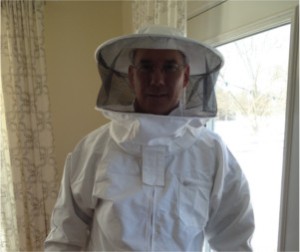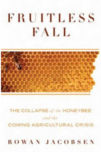 Well, the good news is that I have managed to purchase the hives, equipment, and clothing I believe is needed to have bees in the spring. The bad news is that it is February in Virginia, with snow on the ground and cold in the air. So the best I can do is take some pictures and keep reading and learning. Here is a picture of me dressed for the bees in my new bee jacket. I was planning to purchase a full-body suit, but am told I would roast in the full heat of summer around here. So a jacket it is.
Well, the good news is that I have managed to purchase the hives, equipment, and clothing I believe is needed to have bees in the spring. The bad news is that it is February in Virginia, with snow on the ground and cold in the air. So the best I can do is take some pictures and keep reading and learning. Here is a picture of me dressed for the bees in my new bee jacket. I was planning to purchase a full-body suit, but am told I would roast in the full heat of summer around here. So a jacket it is.
This past week in bee school we learned about bee diseases and pests, from the tiny viruses to the dreaded mites and the much larger skunks and bears. Our teacher was Virginia Apiary Inspector Bob Wellemeyer. You may recall that I wrote about Bob’s talk on on migratory beekeeping at our local December 2014 meeting.
I failed to do the reading this past week (I’m catching up on this now, honest!) and had forgotten just how many diseases there are out there. Lots of diseases affect the young, from chalkbrood to sacbrood to foul brood, to name a few. Adult bees have Nosema virus and deformed wing virus, though the larger problem for adults are the varroa mites, small hive beetles, and wax moths.
I don’t want to review such diseases and pests in detail; a simple search will find more information than you care to read. Overall, my impression is that bees do fairly well on their own, and diseases rarely gain a foothold unless the colony is weak or stressed. Of course, a skunk or bear can take out a hive, but the main problem these days is the varroa mite. These mites multiply exponentially in a hive, resulting in a weak and stressed colony. So if you can handle the mites the bees can take care of most problems on their own. Not everything, of course, but many.
There is a whole movement called Treatment-Free (TF) Beekeeping that argues that we should let the bees learn to deal with varroa on their own. That is, allow evolution to run its course and produce a bee that can live with varroa. Of course, you must have the courage and the hive numbers to do this, as using chemical treatments has a much better success ratio. The problem, however, is that the mites and other creatures slowly evolve to better resist the chemicals. So the chemical companies devise stronger and possibly more virulent treatments to deal with the enhanced pests and diseases.
One well-known TF beekeeper is Kirk Webster, who writes about his frustration with the commercial beekeeping industry’s dependence on chemicals. He suggests how to become treatment-free and fully admits how difficult it is, a journey filled with heavy losses and disappointments.
The basic strategy is to start with good, strong bees with some hygienic traits and build up your hives so you can weather the losses year to year. He claims that year 3 is the hardest, and that by year 4 you might start to see some success. Kirk also points out that if the local genetics are full of treated bees, then his approach may well be impossible. This is a potential problem in my area, where the weather is not kind to bees and most of the area keepers use some level of treatment.
I have been reading many of the posts on the beesource.com site, where an entire forum is devoted to treatment-free beekeeping. Not everyone follows good rules of etiquette, but most people do and freely share their experience and encouragement. Many of these beekeepers that have taken the TF beekeeping plunge and do not use treatments with their bees.
 While I’ve been thinking about all this, I recently listened to Rowan Jacobsen’s 2008 book Fruitless Fall: The Collapse of the Honey Bee and the Coming Agricultural Crisis. This covers the history and some of the scientific research behind Colony Collapse Disorder (CCD) and other challenges of modern beekeeping. The title comes from a quote in Rachel Carson’s book Silent Spring about what could happen if the bees disappeared and fruits and other plants were not pollinated. The book may be a little out of date for 2015, but the writing is superb.
While I’ve been thinking about all this, I recently listened to Rowan Jacobsen’s 2008 book Fruitless Fall: The Collapse of the Honey Bee and the Coming Agricultural Crisis. This covers the history and some of the scientific research behind Colony Collapse Disorder (CCD) and other challenges of modern beekeeping. The title comes from a quote in Rachel Carson’s book Silent Spring about what could happen if the bees disappeared and fruits and other plants were not pollinated. The book may be a little out of date for 2015, but the writing is superb.
The metaphors in Fruitless Fall are especially vivid. To describe migratory beekeeping, he says to imagine waking up early, downing a few sodas, and working in the fields all day. His chapter on the life of a honey bee is a gem, as he describes the six-week life-cycle of a warm-weather bee. Each bee starts out cleaning their own cell until finally foraging for resources outside the hive. The detailed discussion of the time between, as the worker bee takes on different roles in support of the hive, is one of the best I’ve read.
Jacobsen also covers the state of honey production, as of 2008 I presume, which is mostly dominated by possibly-diluted honey from China. The description of Chinese agriculture, especially for honey, is likely to make many readers give up food imports from China altogether.
Fruitless Falls ends, as you might expect, on the future of honey bees. Jacobsen discusses the relentless pursuit of big agriculture, and how bees struggle to stay healthy feeding from a single crop — monoculture, as it is called. He then lauds the promise of treatment-free bees such as those managed by Kirk Webster, and the growing public awareness of the need to reduce chemical treatments in agriculture.
I haven’t fully decided how to manage my bees this year, but I’ll start with the recommendations from my local beekeeping association. I still have a lot to learn, but I’m still having fun learning it. The bees come in six weeks!
The title, of course, is based on the idiom All dressed up and no place to go. Replacing the “to go” with “to bee” seemed appropriated as I was showing off my new bee jacket to my oldest daughter.
Some writers place the origin of the phrase All Dressed Up and No Place to Go to the song from the 1913 musical Beauty Shop, which you can hear at the Library of Congress web site. A brief quote:
When you’re all dressed up and no place to go,
Life seems weary, dreary and slow. My heart has
ached and bled for the tears I’ve shed, when I’d
no place to go unless I went back to bed.
According to the Historically Speaking blog here on WordPress, however, the quote appears on a 1837 tombstone in Thermont, Maryland that reads “Here lies an atheist. All dressed up and no place to go.” So perhaps the phrase was common before that, or perhaps the witty non-believer originated the wording. We may never know.
Thanks for the book review, it sounds interesting.
There are different levels of chemical treatments. Some commercial and hobby beekeepers use antibiotics as a precautionary treatment against AFB – not a good idea as it can weaken the colony and mask the symptoms of AFB if it does outbreak. Using these antibiotics is illegal in the UK.
I’m happy using a thymol based treatment (Apiguard) and oxalic acid, which don’t seem to be too harsh on the bees but do get a good mite drop. So far there are no signs of the mites becoming resistant to these treatments.
MAQs strips, which use formic acid (like ants!) launched recently. Some beekeepers have had great success with these, but I’m wary because some people I know have lost queens after treating with MAQs.
LikeLike
Thanks Emily. I would likely prefer the “softer” treatments you mention, as we call them here.
LikeLike
In the USA there is also Hopguard. Supposedly no harm at all to brood, no effect on the honey, no buildup in wax, etc. Probably the first thing we will try this year now that we are not ignoring mites any more.
Only downside may be less than clear instructions unless those have been fixed since Rusty wrote these: http://www.honeybeesuite.com/tag/hopguard/
LikeLike
Prospect: yes, Hopguard is on the short list. I’ve heard some beekeepers have problems with it around here, but I saw Rusty’s post on Honey Bee Suite as well, so that could explain it. Right now planning to check for mites and treat only if I have to.
LikeLike
I think an important part of the treatment programme is monthly monitoring of mites with record keeping year round. Regularly monitoring shows the peaks and flows of varroa, and other pests or diseases, within a colony alongside other factors, which can help give you a better idea of when a condition has risen to a level in the hive that is not ‘normal’ and needs treating. If that makes sense?
LikeLiked by 1 person
Yes, it does. I saw your post on record keeping and made a copy of your form :). I’ve spoken with a number of beekeepers that have tried electronic record keeping only to fall back on paper and pen as a more reliable source. I have notebook all ready and screen bottom boards so I can measure the mites.
LikeLiked by 1 person